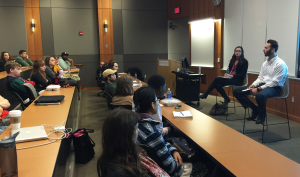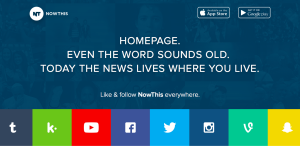Today I visited my alma mater — the Philip Merrill College of Journalism at the University of Maryland — to speak to seniors about careers in media. They’re all members of Leslie Walker’s “Business of News” class. Walker spent 16 years writing and editing for The Washington Post. She was also the editor in chief of washingtonpost.com.

Among the topics she asked me to address were the top trends driving the business of news. So here’s what I came up with (credit goes to my colleague Laurie Petersen, who helped inform some of these ideas with insights from a recent women and journalism symposium):
1. Blurred Lines: The gray area that sits between editorial and advertising/PR is not new. It has existed since the beginning of journalism. But it’s morphing in new and interesting ways that are worth watching closely. I mentioned the Butler University controversy where the institution swapped out a journalism professor with a PR staffer as the adviser to its student newspaper. This called into question whether reporters at college papers have the same freedom of expression afforded to professional journalists.
2. To Profit or Not to Profit: We talked about speculation that the Philadelphia Inquirer is gunning to go non-profit and align itself with Temple University. This Neiman Labs piece explains why that’s easier said than done. We’ve also heard that more journalists are seeking fellowships in order to cover subjects that matter to them. Consumer Reports has been non-profit from the start, of course, and other newer entrants, such as the Texas Tribune and ProPublica, are as well.
3. Algorithm vs. Human: Who decides what’s news? Several predictive analytics companies have surfaced in recent years suggesting the algorithm is acting as editor. Check out Dataminr, for example, which scours Twitter and forecasts what will become newsworthy. Newsrooms all over the map are subscribing to their service. Plus, their recently appointed President of News comes from Reuters. Some information services rely on humans (reportedly Apple News) while others lean exclusively on algorithms (reportedly Facebook), but the answer for most is both.
4. Distribution is King: There’s no doubt now; social channels are the #1 gateway to the news. Any journalist who wants to have a future in this business should understand how to distribute their content. Again, we’re seeing new companies come up focused on this trend, such as Storyful or Reported.ly. I’m also really intrigued by NowThis News, which gave up its traditional website with this gateway of their own:
5. More Than Words: All journalism is multimedia. A reporter is expected to not only craft a great story in words, but often to shoot video and images, and even crunch data into graphics. The name of the game is data visualization and it satisfies people’s ever-decreasing attention spans. We also recently learned that staffers at a major daily are being taught HTML.
The students had lots of interesting questions to ask of me and my fellow presenter, Jared Favole, who served as the White House Correspondent to the Wall Street Journal and currently works in public affairs. I hope what we had to say was useful. What trends did we miss?

